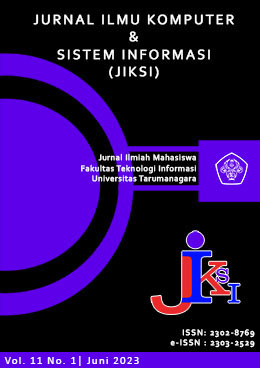KLASIFIKASI HASIL BELAJAR SISWA MENGGUNAKAN METODE C4.5 BERDASARKAN RIWAYAT AKADEMIK DI SMP XYZ
Main Article Content
Abstract
This research was conducted to classify student learning outcomes at XYZ Middle School based on academic history during learning and student learning interests. This study aims to provide information to students and teaching staff regarding student learning outcomes. With the available information, it is hoped that teaching staff can develop methods for conveying material in order to obtain better results. The method used in solving this problem is the C.45 algorithm method. Starting from collecting data consisting of assignment scores, daily tests, UTS, and UAS. Then the formation of a decision system as initial data that has condition and decision attribute values. Then calculate the entropy value of each attribute. Calculating the highest gain value which will then be used as a node. Then, determine the decision from the results of the decision tree process by starting from the highest root to the lowest root to determine the decision criteria.
Article Details

This work is licensed under a Creative Commons Attribution-NonCommercial-ShareAlike 4.0 International License.
This work is licensed under a Jurnal Komunikasi Creative Commons Attribution-ShareAlike 4.0 International License.
References
Fanny Irnanda, Khairunisa ; Hartama, Dedy; Windarto, Agus Perdana. Analisa Klasifikasi C4.5 Terhadap Faktor Penyebab Menurunnya Prestasi Belajar Mahasiswa Pada Masa Pandemi, JURNAL MEDIA INFORMATIKA BUDIDARMA, Vol 4. No.1 2020
Sembiring, Muhammad Ardiansyah; Sibuea, Mustika Fitri Larasati; Sapta, Andy ,ANALISA KINERJA ALGORITMA C.45 DALAM MEMPREDIKSI HASIL BELAJAR, JOURNAL OF SCIENCE AND SOCIAL RESEARCH Vol 1, No. 1. 2019.
Faishal; Kukuh, Hilmi,ANALISA TINGKAT KEMAMPUAN BELAJAR SISWA MENGGUNAKAN METODE C4.5 Studi Kasus : SMPN 2 Keresi TA 2020/2021,https://eprints.amikom.ac.id/view/creators/Faishal=3AHilmy_Kukuh=3A=3A.html, 2022.
Novianti; Rismawan, Tedy; Bahri, Syamsul. IMPLEMENTASI DATA MINING DENGAN ALGORITMA C4.5 UNTUK PENJURUSAN SISWA (STUDI KASUS: SMA NEGERI 1 PONTIANAK), https://jurnal.untan.ac.id/index.php/jcskommipa/article/view/17034, Vol 4, no. 1. 2016



